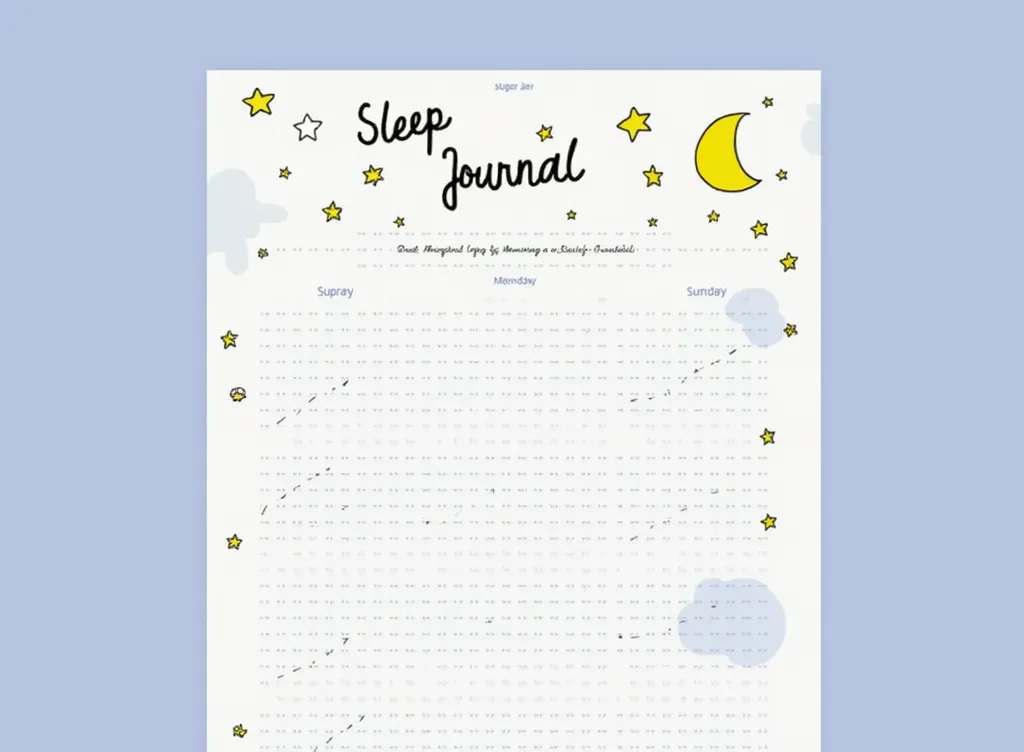Are you tired of tossing and turning, desperately counting sheep while quality sleep remains elusive? In today’s fast-paced world, sleep has become the luxury we can’t afford to ignore – yet nearly 70% of adults struggle with sleep-related issues. From cognitive function to emotional resilience, quality sleep acts as the foundation of our overall well-being,
serving as nature’s reset button for our mind and body. Understanding the science behind sleep and implementing effective tracking methods could be the game-changer you need for transforming your nights from restless to restorative.
Understanding the Importance of Sleep
You can’t live your best life if sleep’s taking a backseat. It’s the unsung hero in keeping your body, mind, and spirit in top shape. Once you get why sleep matters, tweaking how you hit the sack can transform your world.
Impact of Sleep on Overall Well-being
Getting good shut-eye is like a mental, emotional, and physical spa. If you don’t snooze well, you’re in for sluggish days, fuzzy thinking, and stress levels through the roof. Knowing the punch that good sleep can deliver might just get you clocking in those z’s.
Key Effects of Sleep on Health
| Impact Area | Rest Up Benefits | Sleep Deprivation Dangers |
|---|---|---|
| Physical Health | Gives your immune system a shot in the arm | Leaves you ripe for catching whatever bug’s going around |
| Mental Health | Elevates your mood and keeps you even-keeled | Cranks up the anxiety dial and drags you down into the dumps |
| Cognitive Function | Sharpens memory and learning | Scrambles your focus and muddies decision-making |
| Productivity | Keeps you on your game | Pulls down your performance like there’s no tomorrow |
Benefits of Tracking Sleep Habits
Ever thought of keeping a diary for your dream adventures? Ditch the guesswork with a sleep journal. Logging your night adventures can help you spot patterns, figure out what’s messing with your rest, and make changes that stick.
“Sleep is the golden chain that ties health and our bodies together.” – Thomas Dekker, English Dramatist
Advantages of Maintaining a Sleep Journal
| Benefit | What’s In It For You? |
|---|---|
| Awareness | Gives you the scoop on your snooze patterns and trends |
| Accountability | Keeps you on track with healthy bedtime habits |
| Personalization | Lets you tweak your sleep game to suit your groove |
| Goal Setting | Helps you set savvy sleep targets you’ll want to reach |
Keeping tabs on when your head hits the pillow doesn’t just clue you into your own routine but also helps you nail a better bedtime ritual. Looking for more tips? Hit up our articles on crafting that perfect morning routine for better sleep and whipping up the ultimate bedtime routine.
Introducing the Sleep Journal Template
Starting a sleep journal can really perk up your sleep and give your well-being a good boost. In this section, we dive into why you’d want to start one and what makes it the real deal for tracking how you snooze.
Purpose of a Sleep Journal
Think of a sleep journal as your personal sleep detective. The goal is to help you crack the case on your sleep patterns and habits. By jotting down how long you sleep, how good it feels, and your bedtime routines, it becomes your secret weapon to spot what’s working or not.
Whether you’re burning the midnight oil at work, juggling family bedtime with the tots, hitting the books late, or surviving those night shifts, a sleep journal’s got your back. It’s not just about knowing your sleep moves—it’s about inspiring you to tweak your habits for a snooze that’s more in your favor.
Here’s why keeping a sleep journal can be a big plus:
| Purpose | What It Does |
|---|---|
| Increase Awareness | Spots patterns and what messes with your sleep. |
| Improve Sleep Quality | Motivates changes for sweeter dreams. |
| Establish Routine | Helps nail down solid sleep habits. |
| Track Progress | Keeps tabs on changes and wins over time. |
Components of an Effective Sleep Journal
An ace sleep journal is all about easy-peasy sections where you log the right details. Here’s what you need to get the most out of it:
- Daily Sleep Entries: Jot down when you hit the hay, when the alarm blares, and any middle-of-the-night wake-ups.
- Sleep Quality Ratings: Give your sleep a score to figure out over time how your rest is stacking up.
- Pre-Bedtime Activities: Fetch details on what you do before bed. Did you watch TV or meditate? It all plays a part in your rest.
- Dietary Notes: Keep track of what you munch or sip, especially late-night snacks or drinks laden with caffeine, to see the effects on sleep.
- Physical Activity Logging: Record your workouts to see if getting moving helps you sleep better.
- Weekly Reflection Pages: Spend some time thinking about how your week of sleep went and how you felt to boost self-awareness.
- Monthly Overview: Take a step back to see the big picture of your sleep over the month.
| Journal Component | What It’s For |
|---|---|
| Daily Sleep Entries | Note exact sleep timings and any disturbances. |
| Sleep Quality Ratings | Rate how solid your sleep was each night. |
| Pre-Bedtime Activities | See how your pre-sleep rituals affect your zzz’s. |
| Dietary Notes | Pinpoint food and drink influences on sleep. |
| Physical Activity Logging | Link workout habits with sleep quality. |
| Weekly Reflection Pages | Gain insights on your sleep behavior. |
| Monthly Overview | View month-long sleep trends. |
By crafting a sleep journal with these elements, folks can get a clear look at their sleep patterns and tweak as needed for a sound sleep. For a few extra tips and tricks to boost your sleep game, check out our guides on crafting a morning routine for better sleep or nailing a bedtime routine.
Customizing Your Sleep Journal
Customizing a sleep journal can boost its usefulness for folks with different daily rhythms and sleep habits. Letting users tweak the journal means they can make it a handy tool that fits their own life and sleep quirks.
Adapting the Journal to Your Life
Getting the hang of personal sleep patterns is the backbone of a good sleep journal. Everyone from busy bees at work to parents, students, and graveyard shifters faces unique sleep hurdles. Here’s a cheat sheet for shaping a sleep journal that jives with various routines:
| Schedule Type | Customization Tips |
|---|---|
| Oddball Work Times | Jot down shift hours and sleep tweaks. |
| Family Life | Add sections for tracking the kids’ Zs. |
| Student Hustle | Mark out slots for balancing study time with rest. |
| Night Owls | Log post-shift naps and recharge periods. |
Popping in adaptable areas in the journal means folks can note their ever-changing sleep patterns. Say, adding notes about energy highs and lows can reveal whether the sleep they’re getting keeps them sharp and firing on all cylinders. Need more routine savvy? Check out our guide on how to create bedtime routine.
Crafting Sections for Your Personal Needs
A top-notch sleep journal is loaded with sections to meet individual desires. Here’s a rundown of the must-haves to crank up a sleep journal’s effectiveness:
| Section | Description |
|---|---|
| Sleep Log | Jot down daily sleep times, snooze length, and quality. |
| Morning Reflections | Space for jotting feelings when waking and energy vibes. |
| Goal Setting | Sections for plotting weekly sleep goals and reasons why. |
| Progress Track | Monthly check on sleep quality and steadiness. |
These bits allow users to mull over sleep habits, aim for manageable goals, and see how they’re improving. For those with a knack for sleep cycles, tucking in a spot for learning the 90-minute sleep cycle can give sleep patterns a boost.
Tweaking a sleep journal with these custom fixes means it’s a handy partner in scoring better sleep quality. Users can dive into nurturing healthier norms by checking out articles like the best time to exercise for sleep and digital sunset routine.
Tracking Your Sleep Patterns
Being aware of sleep habits is like keeping tabs on the VIP guest list of your own well-being party—it’s essential for feeling great and getting quality shut-eye. A sleep journal can be a game changer, offering handy sections for noting down daily events, weekly musings, and a big-picture monthly view.
Daily Entry Sections
Here’s where it all starts: daily entries. This spot in your journal is all about noting the juicy details of each night’s sleep adventure. You jot down times, like when you hit the hay and when the sun jolts you awake, the hours you snore like a champion, and whether you slept like a baby or thrashed around like an upset toddler. Also, scribble any stuff from the day that might mess with your snooze, like guzzling coffee at 5 PM or stress from that wild office drama.
| Date | Bedtime | Wake-Up Time | Total Sleep (hrs) | Sleep Quality (1-5) | Notes |
|---|---|---|---|---|---|
| 09/01 | 10:30 PM | 6:30 AM | 8 | 4 | Felt restless after 3 AM |
| 09/02 | 11:00 PM | 7:00 AM | 8 | 5 | Great sleep, exercised before bed |
| 09/03 | 12:00 AM | 6:00 AM | 6 | 3 | Had caffeine late in the day |
Weekly Reflection Pages
Here comes the fun part—taking a step back at the end of each week to see the bigger picture. This is where you put on your detective hat and look for trends. Did you nudge your average sleep up a notch? Were you snoring or stressing less? Maybe you’ve spotted the villain that’s sabotaging your sweet dreams.
| Week | Average Sleep (hrs) | Average Quality (1-5) | Notable Issues | Adjustments Needed |
|---|---|---|---|---|
| Week 1 | 7.5 | 4 | Late nights | Reduce screen time before bed |
| Week 2 | 6.5 | 3 | Stress from work | Incorporate relaxation techniques |
| Week 3 | 7 | 4.5 | Good overall | Maintain this routine |
Monthly Overview
Time to zoom out and see the whole sleep saga over the month. This is the grand roundup of what went down, kind of like flipping through the highlights reel. You look at victories won from those weekly summaries, notice patterns, and maybe even set a new goal or two for a better snooze in months ahead.
| Month | Total Sleep Days | Average Duration (hrs) | Improvements Made | Recommendations |
|---|---|---|---|---|
| September | 24 | 7.5 | Introduced bedtime routine | Continue evening wind-down |
| October | 20 | 6.8 | Focused on sleep hygiene | Limit caffeine post-3 PM |
Being diligent with sleep tracking shines a light on how lifestyle choices impact snooze time and reveals that keeping a steady routine is the secret sauce. For more tips on catching those Zs, check out our reads on morning routine for better sleep and how to create bedtime routine.

Analyzing Your Sleep Data
When you scribble away in a sleep journal, it’s not just doodles; you’re brewing up a treasure trove of insights. Soon, you’ll be able to connect the dots, spot patterns, and maybe even crack the code to better sleep – because who doesn’t want to wake up feeling like a million bucks?
Identifying Patterns and Trends
With each log entry, you’re painting a picture of your snooze habits. Over time, these entries reveal which factors rock you gently to sleep and which ones are pulling an all-nighter with you.
| Days of the Week | Average Hours of Sleep | Wake-Up Energy Level (1-10) |
|---|---|---|
| Monday | 6.5 | 6 |
| Tuesday | 7.0 | 7 |
| Wednesday | 5.5 | 4 |
| Thursday | 7.5 | 8 |
| Friday | 8.0 | 9 |
| Saturday | 9.0 | 10 |
| Sunday | 6.0 | 5 |
What jumps out here? Well, weekdays are like a pesky alarm clock, and weekends are a comfy pillow. Spot these trends, and you’re on your way to tweaking life for better zzz’s. Articles like Fix Weekend Sleep Schedule have some handy tips for hitting the snooze button on irregular sleep.
Making Adjustments for Better Sleep
Seeing a pattern? Time to mix things up! Just a few changes can transform your sleep from meh to magnificent.
- Optimize Sleep Environment: Turn your bedroom into a sanctuary. Think cool room, blackout curtains, and a mattress that feels just right.
- Consistent Sleep Schedule: Stick to the same sleep routine, even on lazy Sundays. Check out consistent sleep schedule benefits for more reasons to stick to your bedtime.
- Limit Stimulants: Cut back on caffeine and avoid heavy meals before you hit the hay. Maybe sip on some best teas for bedtime routine to unwind instead.
- Incorporate Relaxation Techniques: Calm your mind with some meditation or light yoga before bed. Peek at the evening routine checklist for more ideas.
Making these tweaks inspired by your own sleep data not only helps you rest better but boosts your overall mood. Over time, you’ll likely notice a delightful ripple effect on how you feel and function, all thanks to the humble sleep journal by your bedside.
Integrating Healthy Habits
Working a few healthy habits into your daily grind can really help you catch better z’s. Toss in some chill activities and relaxation moves, and you’ll be all set for some solid shut-eye.
Adding Wellness Practices to Your Routine
Bringing wellness tricks into your everyday life can really boost your sleep. Here’s a bunch of practices you might wanna mix into your routine to create a sleep-friendly vibe:
| Wellness Practice | What It Does |
|---|---|
| Regular Exercise | Moving your body regularly can help you snooze better by kicking stress and anxiety to the curb. Shoot for at least 30 minutes a day. Check out our guide on the best time to exercise for sleep for the lowdown. |
| Healthy Eating | Eating a balanced diet with loads of fruits, veggies, and whole grains gives you the good stuff your body needs to feel great all around. |
| Hydration | Staying hydrated makes sure your body runs smooth all day long, but remember to slow your sips before bed to avoid those nighttime toilet trips. |
| Consistent Sleep Schedule | Hitting the hay and rising with the roosters at the same time every day keeps your body clock happy. See why this matters over at our consistent sleep schedule benefits page. |
Incorporating Relaxation Techniques
Adding some chill-out techniques before you hit the sack can totally upgrade your sleep. Here’s a smorgasbord of ways you can unwind:
| Relaxation Technique | What It Does |
|---|---|
| Mindfulness Meditation | Getting your zen on with some mindfulness or guided meditation can shrink stress, boost awareness, and help you find your calm. For tips, peek at our screen-free bedtime activities. |
| Deep Breathing Exercises | Taking deep breaths slows your ticker and takes down anxiety. You can do these simple tricks anywhere. |
| Aromatherapy | Using essential oils like lavender sets the mood for a relaxing sleep space. Try using a diffuser in your bedroom for max chill. |
| Warm Bath or Shower | A warm soak or rinse before bed loosens up your muscles and hikes up your body temperature a bit, which signals lights-out as you cool down. Dive into more with our digital sunset routine. |
Jamming these wellness and relaxation moves into a sleep journal is a smart way to track your progress and see what really clicks. Keeping a sleep journal helps nail down a solid bedtime routine and can make your sleep quality skyrocket. Scope out our full guides on how to create a bedtime routine and our evening routine checklist to get more advice and stick with it.
Sharing Your Progress
Keeping track of your snooze goals can make a sleep journal as effective as a shot of espresso in the morning (but way healthier). Having support peeps keeps you pumped and on track like a pro.
Accountability Buddies
Teaming up with someone can really boost your chances of getting that quality shut-eye. This could be your buddy from yoga class, your sibling, or even your little green friend, Kermit (well, maybe not him, but you get the drift). By checking in with each other, you’ll keep each other in line – like personal trainers, but for sleep!
Here’s a nifty way to track your progress with your sleep partner:
| Buddy’s Name | Catch-Up Date | Goals for the Week | How’s It Going? |
|---|---|---|---|
| Jane | MM/DD/YYYY | Hit the hay by 10 PM | Feeling great and rested |
| Tom | MM/DD/YYYY | No screens after 9 PM | Nailed it! Slept like a baby! |
By jotting this down, you’ll see where the struggle’s real and where the wins happen. Plus, who doesn’t like a little team spirit, right?
Online Squad for Sleep Wins
The internet’s full of folks sharing sleep stories. These digital hangouts are spot-on for swapping tips, asking questions, and getting a kick outta each other’s victories. Whether you’re figuring out if a warm milk before bed really works or finding the best lullabies sans lyrics, these spaces can give solid advice.
Here’s the lowdown on what you might find in these communities:
| Type of Group | Why They’re Awesome |
|---|---|
| Forums | Swap hacks and tricks |
| Social Groups | Share what’s working (or not!) for ya |
| Blogs | Read up on sleep tips and trends |
Jumping into these conversations can teach you some legit sleep tricks, like setting a regular snooze alarm, trying out morning rituals, or learning the mystery of the 90-minute sleep cycle.
Using buddies and online communities can supercharge your sleep journal efforts like giving a car a tune-up. It’s all about getting back to those dreamy nights and better sleep habits.
Sustaining Your Sleep Routine
Keeping your sleep on track might just be the secret sauce to living your best life. And hey, keeping a sleep diary isn’t just for the overachievers. Regular check-ins and tweaks will have you snoozing like a pro.
Reviewing and Updating Your Journal
Think of your sleep journal like a buddy you catch up with regularly. It’s all about taking a peek at your sleep patterns—Did you find yourself counting sheep or dreaming sweetly? Whether once a week or monthly, a regular catch-up is the way to go.
| Check-In Frequency | What to Look At |
|---|---|
| Weekly | Spot any pesky habits and quick fixes |
| Monthly | See big-picture shifts and tweak for the long haul |
When making updates, it’s kinda like redecorating a room. Keep what works, toss what doesn’t. Jotting down stuff like night-time disturbances or new habits gives you the lowdown on your Zzz’s.
Tips for Long-Term Success
Want to snooze like a champ? Here’s some handy-dandy advice:
- Stick to a Predictable Sleep Schedule: Hitting the hay and rising with the roosters at the same time sets your body’s clock on cruise control. Dive into more about consistent sleep schedule benefits if you’re curious.
- Create a Chill Bedtime Routine: Think of it as your time to unwind and relax. If you’re stumped for ideas, check out our guide on how to create a bedtime routine.
- Get Moving Daily: A bit of exercise can be a game changer for your sleep. Discover when to workout in our piece on the best time to exercise for sleep.
- Wind Down with Relaxation: Stuff like meditation or mellow stretching can really help your brain power down. Our handy evening routine checklist might be your new best friend.
- Screen Curfew Before Bed: Dimming screens lowers tech’s disruption of your natural sleep hormones. Peek at some screen-free bedtime activities to fill that time.
- Use a Bedtime Calculator: Knowing your sleep cycles can make a world of difference for when to hit the sack and when to rise. Our best bedtime calculator is a great tool for this.
Rolling these tips into your day along with updating your journal helps polish your sleep game. Soon enough, it’s hello better dreams, goodbye grogginess.
Conclusion
Your journey to better sleep starts with understanding and ends with action. By maintaining a sleep journal, you’re not just tracking numbers – you’re investing in your physical health, mental clarity, and emotional well-being. Remember, quality sleep isn’t a luxury; it’s a necessity that impacts every aspect of your life, from your productivity at work to your relationships at home. Whether you’re struggling with occasional sleeplessness or looking to optimize your rest, the tools and techniques we’ve explored provide a roadmap to more restful nights and energized days. Take the first step today by implementing these strategies, and watch as better sleep transforms your world, one night at a time.
FAQs
Q: Why is keeping a sleep journal important?
A sleep journal helps identify patterns in your sleep behavior, tracks factors affecting your sleep quality, and provides valuable insights for improving your sleep habits. It’s an evidence-based tool for developing better sleep hygiene.
Q: How long should I maintain a sleep journal to see results?
Most sleep experts recommend keeping a journal for at least 2-4 weeks to establish baseline patterns and identify trends in your sleep behavior.
Q: What should I track in my sleep journal?
Key elements include bedtime, wake time, sleep quality, pre-bed activities, caffeine/alcohol intake, exercise, stress levels, and any nighttime disturbances.
Q: Can a sleep journal help with insomnia?
Yes, sleep journals are often recommended by sleep specialists as they help identify triggers and patterns that may contribute to insomnia, making it easier to develop effective treatment strategies.
Q: How accurate are sleep journals compared to sleep tracking devices?
While sleep-tracking devices provide automated data, sleep journals offer valuable subjective information about sleep quality and habits that devices can’t measure, making them complementary tools.
Q: Is it necessary to track sleep every single day?
While consistent tracking provides the most complete data, even tracking 3-4 days per week can offer valuable insights into your sleep patterns and habits.
Additional Resources and Authority References
- National Sleep Foundation: https://www.sleepfoundation.org/
- Sleep Research Society: https://www.sleepresearchsociety.org/
- Harvard Health Sleep Division: https://healthysleep.med.harvard.edu/
- Centers for Disease Control and Prevention – Sleep Section: https://www.cdc.gov/sleep/
- American Academy of Sleep Medicine: https://aasm.org/






